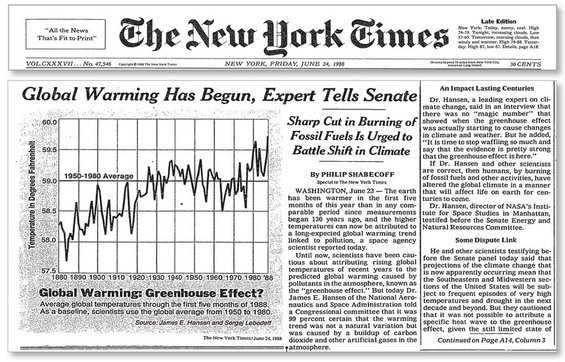James Edward (Jim) Hansen is a leading climate researcher. He played a significant role in the emergence of predictive modeling. As an expert in solar radiation transfer in planetary atmospheres at the Goddard Institute of Space Studies of NASA, he began modelling radiative transfer in the Earth’s atmosphere in 1970. During the 1970s, Hansen became a leading climate modeling expert. In 1981 he and his collaborators published the first long term projections of climate based on model simulations in the journal Science (Hansen et al. 1981). Though this paper was very controversial, it set the stage of predictive modeling in the following years and decades.
Hansen was the son and one of seven children of a tenant farmer in Iowa. He studied physics and astronomy at the University of Iowa, among other with the outstanding scientist, James van Allen. In 1967 he joined the Goddard Institute for Space Studies (GISS) in New York as a postdoctoral candidate and specialized in theoretical work on radiative transfer in planetary atmospheres. Around 1970, Hansen joined a weather prediction modeling project based on Arakawa’s general circulation model and started focus on climate modeling in the following years.
Hansen developed ingenious modeling approaches by simplifying climate models for specific tasks. Many ambitious studies he pursued were based on a one-dimensional model, which only represented the vertical axis of the atmosphere. With this approach he could circumvent limits of computational power and apply the model for simulations of complex problems. He later explained his interests and ambitions in an interview with Spencer Weart:
“We’re taking the model and using it for climate applications. It’s hard to have enough time to work on the basic structure of the model and also use it” (Weart 2000).
A one-dimensional model also served for the 1981 landmark paper in Science. In spite of a large amount of significant uncertainties, the authors developed trust in their model, because it reproduced past global mean temperature changes rather well. This achievement encouraged them to venture into simulating climate projections based on socio-economic assumptions regarding future CO2 emissions to the year 2100. In 1988 Hansen and his group published for the first time climate projections simulated with a three-dimensional climate model (Hansen et al. 1988).
Hansen became famous for his testimony before Congress in June 1988. In this summer the USA experienced an extraordinary heat wave. Hansen clearly expressed his conviction that climate warming was already happening:
"Number one, the earth is warmer in 1988 than at any time in the history of instrumental measurements. Number two, the global warming is now large enough that we can ascribe with a high degree of confidence a cause and effect relationship to the greenhouse effect. And number three, our computer climate simulations indicate that the greenhouse effect is already large enough to begin to effect the probability of extreme events such as summer heat waves."
Hansen’s famous testimony before Congress on 23 June 1988 (Hansen 1988, p. 39).
This testimony brought him ample press coverage as well as significant criticism. It caused a steep rise of public attention to global warming. “Global warming has began, Expert tells Senate,” titled the New York Times on its front page on June 24, 1988:

Hansen making headlines (Source: http://www.ucsusa.org/sites/default/files/images/2015/06/gw-graphic-new-york-times-1988-hansen-testimony-front-page.jpg).
Hansen, James E. et al. 1981. Climate Impact of Increasing Atmospheric Carbon Dioxide, Science 213, pp. 957–66.
Hansen, James E., et al. (1988). "Global Climate Changes as Forecast by Goddard Institute for Space Studies 3-Dimensional Model." Journal of Geophysical Research 93, pp. 9341-64.
Weart, Spencer (2000). Interview with James Hansen, Center for History of Physics. College Park: American Institute of Physics. Transcript: http://www.aip.org/history/ohilist/24309_1.html.